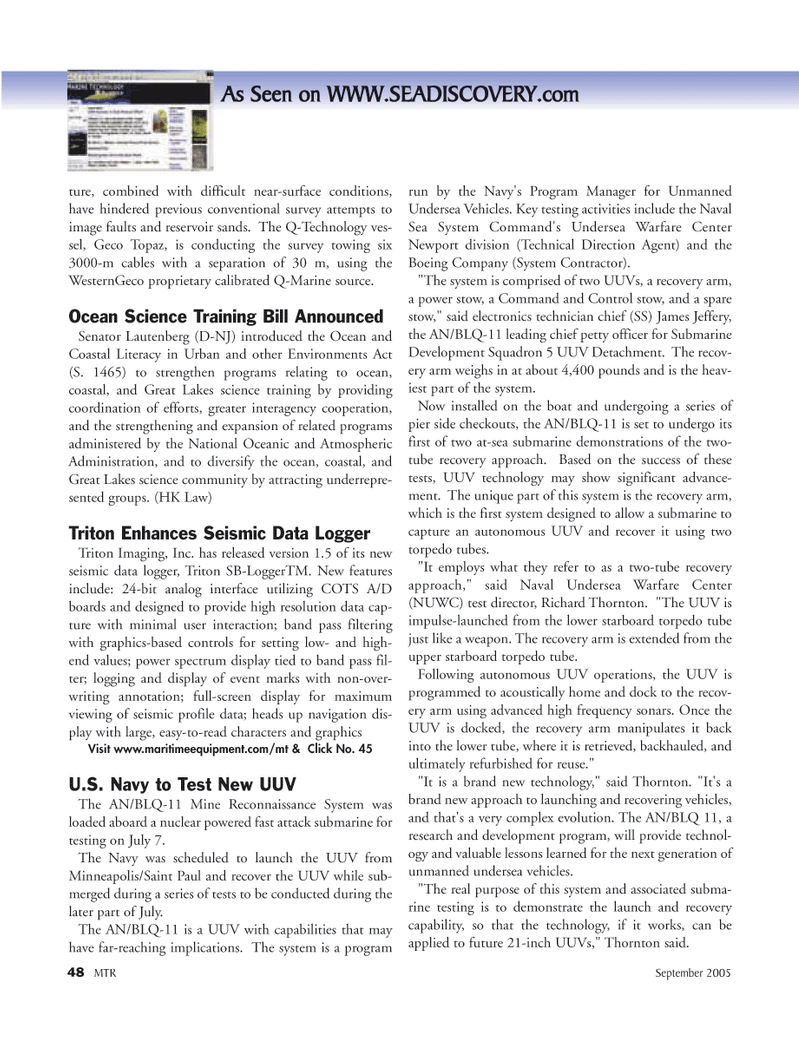
Page 48: of Marine Technology Magazine (September 2005)
Maritime Security & Undersea Defense
Read this page in Pdf, Flash or Html5 edition of September 2005 Marine Technology Magazine
48 MTR September 2005
As Seen on WWW.SEADISCOVERY.com ture, combined with difficult near-surface conditions, have hindered previous conventional survey attempts to image faults and reservoir sands. The Q-Technology ves- sel, Geco Topaz, is conducting the survey towing six 3000-m cables with a separation of 30 m, using the
WesternGeco proprietary calibrated Q-Marine source.
Ocean Science Training Bill Announced
Senator Lautenberg (D-NJ) introduced the Ocean and
Coastal Literacy in Urban and other Environments Act (S. 1465) to strengthen programs relating to ocean, coastal, and Great Lakes science training by providing coordination of efforts, greater interagency cooperation, and the strengthening and expansion of related programs administered by the National Oceanic and Atmospheric
Administration, and to diversify the ocean, coastal, and
Great Lakes science community by attracting underrepre- sented groups. (HK Law)
Triton Enhances Seismic Data Logger
Triton Imaging, Inc. has released version 1.5 of its new seismic data logger, Triton SB-LoggerTM. New features include: 24-bit analog interface utilizing COTS A/D boards and designed to provide high resolution data cap- ture with minimal user interaction; band pass filtering with graphics-based controls for setting low- and high- end values; power spectrum display tied to band pass fil- ter; logging and display of event marks with non-over- writing annotation; full-screen display for maximum viewing of seismic profile data; heads up navigation dis- play with large, easy-to-read characters and graphics
Visit www.maritimeequipment.com/mt & Click No. 45
U.S. Navy to Test New UUV
The AN/BLQ-11 Mine Reconnaissance System was loaded aboard a nuclear powered fast attack submarine for testing on July 7.
The Navy was scheduled to launch the UUV from
Minneapolis/Saint Paul and recover the UUV while sub- merged during a series of tests to be conducted during the later part of July.
The AN/BLQ-11 is a UUV with capabilities that may have far-reaching implications. The system is a program run by the Navy's Program Manager for Unmanned
Undersea Vehicles. Key testing activities include the Naval
Sea System Command's Undersea Warfare Center
Newport division (Technical Direction Agent) and the
Boeing Company (System Contractor). "The system is comprised of two UUVs, a recovery arm, a power stow, a Command and Control stow, and a spare stow," said electronics technician chief (SS) James Jeffery, the AN/BLQ-11 leading chief petty officer for Submarine
Development Squadron 5 UUV Detachment. The recov- ery arm weighs in at about 4,400 pounds and is the heav- iest part of the system.
Now installed on the boat and undergoing a series of pier side checkouts, the AN/BLQ-11 is set to undergo its first of two at-sea submarine demonstrations of the two- tube recovery approach. Based on the success of these tests, UUV technology may show significant advance- ment. The unique part of this system is the recovery arm, which is the first system designed to allow a submarine to capture an autonomous UUV and recover it using two torpedo tubes. "It employs what they refer to as a two-tube recovery approach," said Naval Undersea Warfare Center (NUWC) test director, Richard Thornton. "The UUV is impulse-launched from the lower starboard torpedo tube just like a weapon. The recovery arm is extended from the upper starboard torpedo tube.
Following autonomous UUV operations, the UUV is programmed to acoustically home and dock to the recov- ery arm using advanced high frequency sonars. Once the
UUV is docked, the recovery arm manipulates it back into the lower tube, where it is retrieved, backhauled, and ultimately refurbished for reuse." "It is a brand new technology," said Thornton. "It's a brand new approach to launching and recovering vehicles, and that's a very complex evolution. The AN/BLQ 11, a research and development program, will provide technol- ogy and valuable lessons learned for the next generation of unmanned undersea vehicles. "The real purpose of this system and associated subma- rine testing is to demonstrate the launch and recovery capability, so that the technology, if it works, can be applied to future 21-inch UUVs," Thornton said.
MTR#2 (33-48).qxd 8/30/2005 5:32 PM Page 48

 47
47

 49
49
